Why Monkfish Deserves a Place on Your Culinary Trip List
Monkfish might just be the ocean’s best-kept secret hiding in plain sight. This unusual fish – often called the “poor man’s lobster” – has been quietly winning over chefs and food lovers around the world with its surprisingly sweet, firm flesh that rivals lobster in both taste and texture.
Quick Monkfish Facts:
- What it is: A bottom-dwelling fish from the anglerfish family with a large, intimidating head and sweet, meaty tail meat
- Taste: Mild, sweet flavor with firm, lobster-like texture
- Size: Can grow over 4 feet long and weigh up to 50 pounds
- Where found: Northwest Atlantic Ocean from Newfoundland to North Carolina
- Best parts to eat: Tail fillets (most common), liver (ankimo delicacy), and cheeks
- Sustainability: Not overfished – considered a responsible seafood choice
Despite its rather unfortunate appearance – with a face that could stop traffic and teeth that look like they belong in a horror movie – monkfish has earned its place in fine dining establishments worldwide. The contrast between its monstrous looks and delicate flavor makes it one of the culinary world’s most interesting contradictions.
For adventurous food lovers seeking authentic experiences, monkfish offers something special. It’s a fish that tells a story – from forgotten “trash fish” to prized ingredient. Whether you encounter it in a rustic Spanish coastal restaurant, a high-end Japanese sushi bar serving ankimo, or a cozy New England seafood house, monkfish connects you to local fishing traditions and sustainable ocean practices.
This guide will take you through everything you need to know about monkfish – from understanding what makes this creature so unique to finding the best ways to prepare it at home. We’ll explore its biology, sustainability story, and culinary potential so you can confidently add this fascinating fish to your next dining trip.
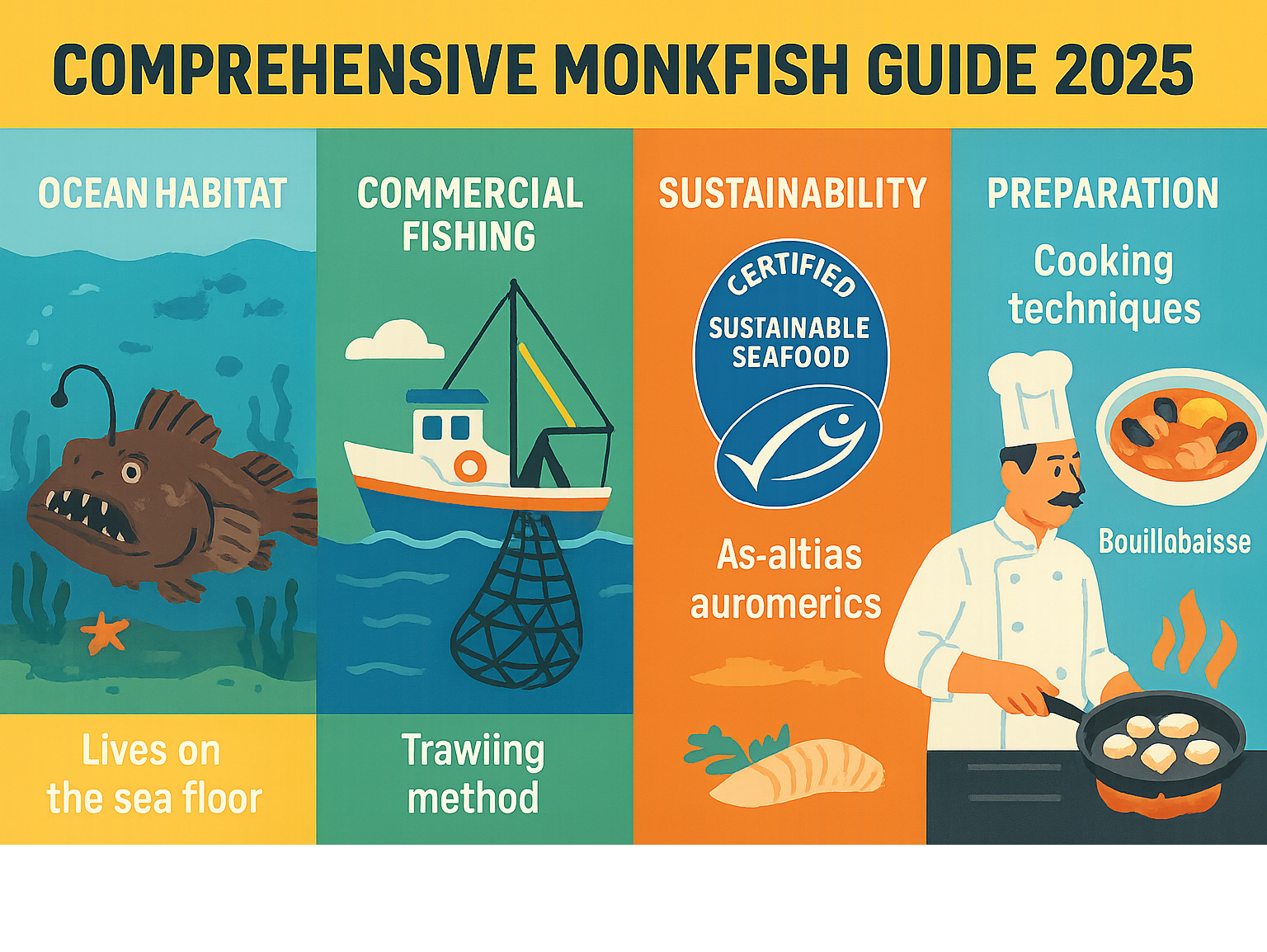
Monkfish vocab explained:
Monkfish Biology & Identification
There’s something wonderfully contradictory about monkfish – they’re proof that you really can’t judge a book by its cover. These remarkable creatures might look like they swam straight out of a nightmare, but they’re actually fascinating examples of perfect evolutionary design. Think of them as the ocean’s ultimate undercover agents, hiding incredible culinary treasure behind one of nature’s most intimidating facades.
Monkfish belong to the anglerfish family and carry the scientific name Lophius, which means “mane” – a nod to those distinctive, flowing dorsal spines that crown their massive heads. They’ve been called many things over the centuries: sea devils, fishing frogs, goosefish, and even belly fish. But perhaps the most telling nickname is “allmouth” – once you see one, you’ll understand why.
What makes these fish truly special is their incredible size potential. While the monkfish fillets you’ll find at your local fish market typically come from 1-4 pound fish, these bottom-dwellers can grow into true sea monsters. We’re talking over 4 feet long and weighing up to 50 pounds – that’s enough fish to feed a small army.
Monkfish Anatomy
The first thing that strikes you about a monkfish is that enormous head, which makes up more than half of their total body weight. It’s like nature decided to build a fish around a mouth rather than the other way around. And what a mouth it is – a cavernous opening lined with rows of sharp, inward-pointing teeth that work like a one-way turnstile for unsuspecting prey.
But here’s where monkfish get really clever. That modified spine sticking up from their head isn’t just for show – it’s a sophisticated fishing rod complete with a fleshy, worm-like lure called an esca. They wave this natural bait around like a master angler, and when curious fish come to investigate what looks like an easy meal, they become the meal instead.
Perhaps most charmingly, monkfish don’t really swim like other fish. Instead, they use their sturdy pectoral fins like little legs to “walk” along the ocean floor. Picture a fish doing an underwater stroll while perfectly camouflaged against the sandy bottom, and you’ve got the monkfish lifestyle down to a science.
Their camouflage game is absolutely on point too. Monkfish can blend so seamlessly with the seafloor that they’re practically invisible until they strike. It’s this combination of patience, camouflage, and that irresistible lure that makes them such effective predators.
Scientific Classification & Species
The Lophius genus includes seven living species scattered across Atlantic and Indo-Pacific waters. For food lovers, the two stars of the show are the white-bellied anglerfish (Lophius piscatorius) found in European waters and the American angler (Lophius americanus) that graces North American tables.
These species have their own personalities – L. piscatorius can reach an impressive 200 centimeters in length, making them the giants of the family, while smaller cousins like L. gastrophysus top out around 67 centimeters. The differences go beyond size too, with subtle variations in coloring, fin structure, and habitat preferences that make each species unique.
What’s fascinating is how these different monkfish species have adapted to their specific environments while maintaining those signature characteristics that make them such prized catches. Whether you’re enjoying monkfish in a seaside restaurant in Maine or trying ankimo at a sushi bar, you’re experiencing the result of millions of years of evolutionary refinement.
For those who love diving deep into the science, you can explore the complete taxonomic breakdown at Species in the genus Lophius to see just how diverse this remarkable family really is.
Where Monkfish Live & How They Behave
Monkfish are true Atlantic natives with impressive range. These fascinating fish make their homes throughout the Northwest Atlantic, from the chilly waters off Newfoundland and the northern Gulf of St. Lawrence all the way down to the warmer coastal areas of North Carolina. They’re equally at home in European waters, ranging from Norway’s fjords down through the Mediterranean’s azure depths.
What makes monkfish particularly remarkable is their incredible adaptability to different depths. While they show a preference for waters less than 330 feet deep, these hardy fish can thrive anywhere from just below the tide line down to nearly 3,000 feet deep. This impressive depth tolerance has been key to their survival and helps explain why their populations have remained relatively stable even as commercial fishing has intensified.

The ocean floor is where monkfish truly shine. They prefer sandy or gravelly bottoms that perfectly complement their natural camouflage abilities. Their mottled brown and olive coloration, combined with those distinctive fringe-like skin flaps around their heads, makes them virtually invisible when they settle into the sediment. It’s nature’s perfect invisibility cloak – until an unsuspecting fish swims by.
These fish aren’t big travelers, but they do make seasonal migrations following their prey and responding to water temperature changes. During spawning season, they’ll move to specific areas where conditions are just right for their remarkable reproductive process.
Monkfish Life Cycle
The way monkfish reproduce is absolutely extraordinary and unlike anything else in the ocean. Instead of simply releasing eggs into the water like most fish, female monkfish create something truly spectacular – massive floating “egg veils” that look like underwater silk curtains.
These incredible structures can stretch 20 to 40 feet long and up to 5 feet wide, containing up to one million tiny pink eggs embedded in a transparent, jelly-like sheet. Imagine spotting one of these ethereal ribbons drifting near the ocean surface during summer months – it’s like finding nature’s own art installation floating in the sea.
The egg veils drift with ocean currents for one to three weeks while the embryos develop. Once hatched, the tiny larval monkfish look nothing like their parents – they’re transparent, planktonic creatures that drift in open water before eventually settling to the bottom and beginning their change into the distinctive adults we recognize.
Monkfish take their time reaching maturity, with females not ready to reproduce until around 9 years old and males maturing slightly earlier at about 6 years. With a maximum lifespan of approximately 11 years, these fish invest most of their lives in growing before they get the chance to create those magnificent egg veils.
Monkfish Feeding Habits
Monkfish have turned patience into an art form. These ultimate ambush predators bury themselves in sand or mud until they’re completely invisible except for their eyes and that famous fishing-rod lure protruding from their heads. Then comes the waiting game – sometimes for hours – until the perfect moment arrives.
When an unsuspecting fish, crab, or lobster gets curious about that wiggling lure and ventures too close, the monkfish strikes with lightning speed. Their enormous mouth opens like a vacuum cleaner, creating such powerful suction that prey gets pulled in faster than the eye can follow. It’s over in milliseconds.
Their appetite is impressively diverse and somewhat terrifying. Monkfish will devour fish, crustaceans, mollusks, and even diving seabirds that make the mistake of swimming too close to the surface. Scientists have found monkfish with prey nearly half their own body size stuffed in their stomachs – a testament to both their hunting prowess and their remarkably expandable digestive system.
This “sit and wait” strategy might seem lazy, but it’s incredibly energy-efficient and devastatingly effective. Why chase your dinner around the ocean when you can simply make it come to you?
From Ocean to Market: Fisheries, Regulations & Sustainability
The monkfish industry tells one of the ocean’s most encouraging success stories. What was once considered a “trash fish” has transformed into a premium seafood worth $11.8 million annually in U.S. markets alone. In 2023, American fishermen landed an impressive 15.4 million pounds of monkfish, making it one of the most valuable finfish species in the Northeast.
This remarkable change didn’t happen by accident. It’s the result of careful management, evolving fishing practices, and a growing appreciation for this unusual fish’s culinary potential. The journey from ocean floor to your dinner plate involves sophisticated systems designed to protect both the species and the marine environment.
Commercial fishermen primarily catch monkfish using two main methods: trawl nets and gillnets. The industry has been shifting away from traditional beam trawling toward more selective gillnet methods, which is great news for ocean health. Gillnets create less bycatch – meaning fewer unintended species get caught – and they’re much gentler on seafloor habitats than heavy trawling gear.
This evolution in fishing techniques shows how the industry has acceptd sustainability as both an environmental responsibility and a business necessity. After all, healthy fish populations mean a thriving industry for generations to come.
Fishery Management Snapshot
Managing monkfish fisheries requires coordination between multiple regional councils, and the system in place is impressively comprehensive. The New England and Mid-Atlantic Fishery Management Councils work together under a joint management plan that treats the fishery as the interconnected system it really is.
The heart of the management system is the Days-at-Sea (DAS) allocation. Fishing vessels receive 35 DAS in the northern areas and 37 DAS in the southern regions. Think of it as a fishing budget – once you’ve used your allocated days, you’re done for the season. This approach helps prevent overfishing while giving fishermen flexibility in when and where they work.
Size limits play a crucial role too. Monkfish must be at least 17 inches long when sold whole, or 11 inches for tail-only sales. These regulations ensure fish have had time to mature and reproduce before being harvested.
One of the most thoughtful aspects of monkfish management involves seasonal closures timed with sea surface temperatures. When waters warm up and sea turtles begin migrating, certain fishing areas close temporarily. It’s a perfect example of modern fishery management considering the entire ecosystem, not just the target species.
For those interested in the technical details, the complete regulations can be found in 50 CFR part 648 subpart F.
Is Monkfish Sustainable?
Here’s the good news for environmentally conscious seafood lovers: monkfish absolutely qualifies as a sustainable choice. Current stock assessments show that monkfish populations are healthy and above target levels. Even better, overfishing is not occurring, which represents a remarkable turnaround from earlier decades.
Several factors make monkfish such a sustainability success story. The comprehensive quota system keeps harvest levels within safe limits, while gear restrictions minimize environmental impact. Area closures protect critical habitats, and seasonal restrictions safeguard other marine species that share monkfish waters.
The shift toward low-profile gillnets has been particularly important for reducing bycatch of sea turtles and other protected species. These modified nets allow turtles to swim over them safely while still effectively catching monkfish.
When shopping for monkfish, look for products with Marine Stewardship Council (MSC) certification or those recommended by Seafood Watch programs. Choosing gillnet-caught over beam-trawled monkfish takes your sustainability commitment one step further by supporting the most environmentally responsible fishing methods.
The monkfish fishery proves that with proper management and industry cooperation, we can enjoy delicious seafood while protecting ocean ecosystems for future generations.
Culinary Guide: Taste, Preparation & Cooking Techniques
Here’s where monkfish truly shines and earns its beloved nickname as “poor man’s lobster.” This isn’t just clever marketing – when you taste properly prepared monkfish, the comparison becomes immediately clear. The flesh offers that same sweet, delicate flavor you’d expect from premium lobster, paired with a satisfying firm, meaty texture that holds up beautifully to almost any cooking method.
What makes monkfish so special in the kitchen is its forgiving nature. Unlike delicate fish that flake apart at the slightest touch, monkfish maintains its structure whether you’re grilling it over high heat, braising it slowly in wine, or threading it onto skewers. The bright white, virtually boneless tail meat readily absorbs marinades and sauces while still maintaining its own distinct character.

The tail is what you’ll find most commonly in markets – two thick, cylindrical fillets that typically weigh between 1-4 pounds each. But don’t overlook the other treasures this fish offers. Monkfish cheeks, while rarely available in U.S. markets, are incredibly flavorful morsels. And then there’s the liver, known as ankimo in Japanese cuisine, which is prized as a delicacy comparable to foie gras in both richness and price.
Preparing Monkfish at Home
The secret to perfect monkfish lies in proper preparation, and there’s one crucial step that many home cooks miss: removing that thin, grayish membrane that covers the fillet. Skip this step, and you’ll end up with fish that curls up like a pretzel and turns disappointingly tough. Take the time to peel away this membrane completely – your taste buds will thank you.
Start by removing any remaining skin if it’s still attached, simply by grasping one end and pulling it straight back in one smooth motion. Trim away any fins or tail remnants with kitchen scissors, then comes the important part – that membrane removal. It should peel away in sheets once you get started, revealing the pristine white flesh underneath.
You can cut your monkfish into individual portions or leave it whole depending on your cooking plans. Either way, let the seasoned fish rest at room temperature for about 15 minutes before cooking. This simple step ensures more even cooking throughout.
For the best results, consider giving lean monkfish fillets a quick brine – even just an hour in salt water helps the fish retain moisture and prevents that dry, tough texture that can happen with overcooking. If you don’t have time for brining, simply salting the fish 30 minutes before cooking makes a noticeable difference.
Our go-to marinade combines olive oil, fresh lemon juice, minced garlic, chopped herbs, salt, and pepper. Thirty minutes is the sweet spot – long enough for the fish to absorb those bright flavors without the acid breaking down the delicate texture. This preparation works beautifully whether you’re planning to grill, pan-sear, or roast your monkfish. For those interested in exploring similar preparation techniques with other seafood, our Salmon Recipe offers complementary methods that work wonderfully with firm-textured fish.
Cooking Methods & Recipes
Monkfish is remarkably versatile in the kitchen, adapting beautifully to almost any cooking method you can imagine. Pan-searing creates restaurant-quality results at home – heat olive oil in a cast iron pan over medium heat, cook your seasoned fillets about 5 minutes per side until golden, then add butter, garlic, and fresh thyme. Tilt the pan and continuously baste the fish with that foaming brown butter for a couple minutes. The nutty, aromatic butter transforms the dish completely.
Grilling brings out wonderful smoky flavors, whether you cut the monkfish into chunks for skewers or grill whole fillets like steaks. The firm texture holds up beautifully to direct heat – just remember to marinate briefly beforehand to keep everything moist and flavorful.
For roasting thick fillets, try the chef’s technique of searing quickly on the stovetop first, then finishing in a 400°F oven for about 20 minutes. This gives you that gorgeous caramelized exterior while ensuring the interior cooks perfectly through.
Where monkfish really excels is in braising and stews. Its firm texture means it won’t fall apart during long, slow cooking, making it exceptional in bouillabaisse, Thai curries, or hearty seafood stews. Try our “Poor Man’s Lobster” recipe for a budget-friendly alternative to expensive lobster rolls that delivers on both flavor and satisfaction.
| Fish | Taste | Texture | Price Range | Best Cooking Methods |
|---|---|---|---|---|
| Monkfish | Sweet, mild | Firm, meaty | $8-15/lb | Pan-sear, grill, braise |
| Lobster | Sweet, briny | Firm, tender | $25-40/lb | Steam, grill, sauté |
| Branzino | Mild, clean | Flaky, delicate | $12-18/lb | Roast whole, pan-fry |
Pairings & Menu Inspiration
The beauty of monkfish lies in how well it plays with bold, assertive flavors. Mediterranean preparations work wonderfully – think herb-crusted dishes with rosemary and thyme, Spanish-style preparations with smoky paprika and garlic, or classic French treatments with white wine and rich butter sauces.
For your next dinner party, consider creating a Mediterranean seafood spread by serving monkfish alongside Branzino for an neat, restaurant-quality meal. Or create an impressive surf-and-turf combination with Filet Mignon that delivers all the luxury of traditional lobster pairings without the premium price tag.
Some of our favorite flavor combinations include brown butter with fresh herbs like parsley, thyme, and chives for a classic French approach. Mediterranean preparations with olive oil, bright lemon, garlic, and sun-dried tomatoes bring out the fish’s natural sweetness. Asian-inspired combinations of soy sauce, fresh ginger, lime, and chile create exciting flavor contrasts, while Spanish-style preparations with paprika, dry sherry, and roasted peppers offer rich, complex tastes that complement the fish’s meaty texture perfectly.
Buying, Storing & Health Considerations
Shopping for monkfish is easier than you might think, though you’ll almost always find it sold as tails rather than whole fish – which honestly saves everyone from some awkward stares at the seafood counter! The key is knowing what to look for to ensure you’re getting the freshest, highest-quality fish.
When examining monkfish at the market, you want bright white flesh that has a slightly translucent quality, almost like it’s glowing from within. The texture should be firm and spring back when you gently press it with your finger. Fresh monkfish has a clean, ocean-fresh smell – never fishy or ammonia-like.
If you’re buying whole tails, look for bright red blood visible along the bone, which indicates the fish is truly fresh. Avoid any fish with gray or yellowing flesh, soft spots, or strong odors. Sometimes you’ll see it labeled as “American angler” – don’t worry, this is the exact same fish with a slightly more appetizing name.

In New York City and other major metropolitan areas, specialty fish markets and higher-end grocery stores typically carry monkfish. Online seafood retailers have also become an excellent option, often providing better quality control and sustainable sourcing information than local markets.
From a health perspective, monkfish is a smart choice. It’s relatively low in mercury compared to larger predatory fish, making it safer for regular consumption. You’re also getting excellent nutritional value – about 14.48 grams of lean protein per 100 grams with only 76 calories and minimal fat content.
Safe Handling Tips
Proper storage makes all the difference with monkfish quality. Store fresh fish in the coldest part of your refrigerator (ideally 32-38°F) and plan to use it within two days of purchase. For longer storage, wrap it tightly in plastic wrap, place in a freezer bag with the air squeezed out, and freeze for up to six months.
The most critical preparation step is removing that gray membrane before cooking. This membrane will cause the fish to curl up like a question mark and develop an unpleasantly tough texture. Take your time peeling it away completely – this one step separates amateur from professional results.
When cooking, monkfish should reach an internal temperature of 145°F. The flesh transforms from translucent to opaque white when properly cooked. Here’s a chef’s trick: insert a paring knife into the thickest part and hold it there for 10 seconds. If the knife feels warm when you pull it out, your fish is perfectly done.
For those with shellfish allergies, monkfish is generally safe since it’s a true fish, not a shellfish. However, always consult with healthcare providers about specific dietary restrictions. The texture similarity to shellfish like Scallops actually makes it an excellent alternative for those who miss that firm, sweet seafood experience but can’t eat shellfish.
Monkfish in Raw Dishes
While most monkfish is served cooked, it can be prepared raw in sushi and sashimi when properly sourced and handled. The liver, known as ankimo, is particularly celebrated in Japanese cuisine, where it’s steamed and served with ponzu or other citrus-based sauces. Many consider ankimo a delicacy comparable to foie gras.
If you’re interested in exploring raw monkfish preparations, always purchase from reputable suppliers who can guarantee proper handling and freezing protocols for raw consumption. The fish must be frozen at specific temperatures to eliminate parasites before being safe for raw preparation.
For those curious about raw fish preparations in general, our comprehensive guide to Sashimi provides essential information about sourcing sushi-grade fish and safe handling practices that apply to monkfish and other species alike.
Economic Importance & Conservation Outlook
The monkfish story is one of the most inspiring turnarounds in American fisheries. What was once considered “trash fish” – literally thrown back overboard as unwanted bycatch – has transformed into one of the Northeast’s most valuable finfish species. The numbers tell an impressive tale: U.S. commercial landings in 2023 were worth $11.8 million, making monkfish a cornerstone of many fishing communities from Maine to North Carolina.
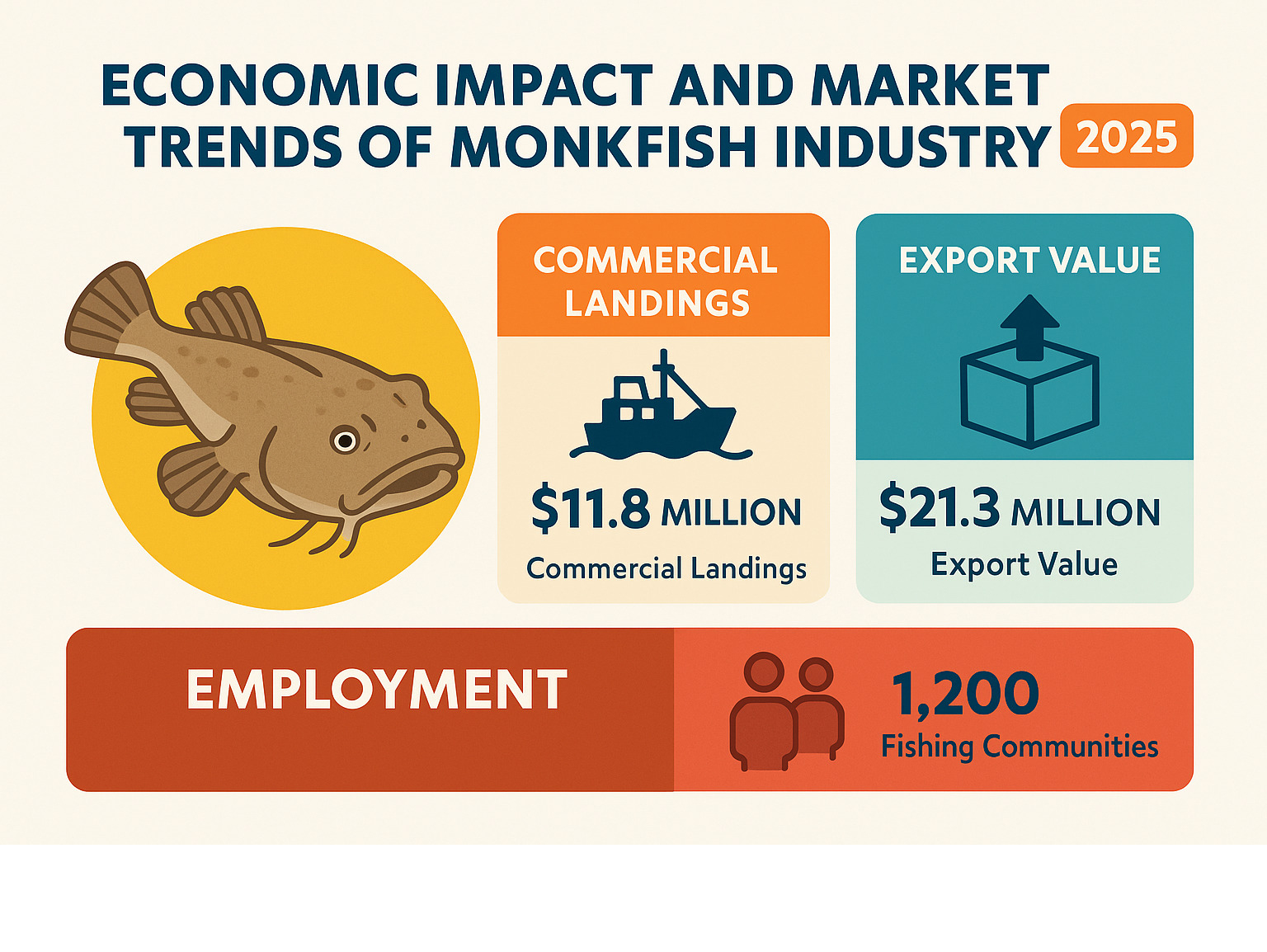
But the economic impact goes far beyond just the fish fillets we see in restaurants. Monkfish liver has become a particularly lucrative export product, with Asian markets paying premium prices for high-quality ankimo. This secondary market has added significant value to each fish, giving fishermen additional income streams and making the entire operation more economically viable.
The change reflects changing consumer tastes and smart marketing. Celebrity chefs began featuring monkfish in their restaurants, food writers started calling it “poor man’s lobster,” and suddenly what fishermen once discarded became a sought-after delicacy. It’s a perfect example of how education and exposure can completely shift market perceptions.
Looking ahead, climate change presents both opportunities and challenges for monkfish populations. These adaptable creatures might actually benefit from some warming trends, potentially expanding their range as ocean temperatures shift. However, changes in prey distribution, spawning conditions, and ocean chemistry require careful monitoring to ensure populations remain healthy.
The rising global demand for sustainable protein sources positions monkfish well for continued growth. As consumers become more conscious about overfished species like bluefin tuna or Atlantic cod, monkfish offers an environmentally responsible alternative that doesn’t compromise on taste or texture.
Supporting Sustainable Choices
Making sustainable monkfish choices is easier than you might think, and your decisions as a consumer directly support responsible fishing practices. When shopping, look for the MSC (Marine Stewardship Council) certification – that blue label guarantees your fish comes from well-managed fisheries with minimal environmental impact.
The fishing method matters too. Gillnet-caught monkfish is generally more sustainable than beam-trawled fish because gillnets are more selective, reducing bycatch of other species and causing less damage to seafloor habitats. Many fish markets and restaurants now provide this information, so don’t hesitate to ask where and how your monkfish was caught.
Supporting restaurants that prioritize sustainable sourcing makes a difference too. Many establishments now highlight their commitment to responsible seafood on their menus, connecting diners directly with the fishing communities that supply their ingredients. This farm-to-table approach – or in this case, boat-to-table – creates a direct line between sustainable fishing practices and consumer demand.
For those interested in exploring how restaurants are embracing these connections, our guide to Farm-to-Table Dining Experiences shows how chefs are building relationships with local suppliers, including the fishing boats that bring us sustainable seafood like monkfish.
The beauty of choosing monkfish is that you’re supporting both environmental sustainability and economic vitality in coastal communities. Every purchase helps maintain jobs for fishermen, dock workers, and seafood processors while encouraging responsible ocean stewardship. It’s a win-win that tastes great too.
Frequently Asked Questions about Monkfish
Why is monkfish called “poor man’s lobster”?
The nickname “poor man’s lobster” isn’t just clever marketing – it’s actually based on monkfish’s genuinely remarkable similarity to lobster in both taste and texture. When you bite into properly prepared monkfish tail, you’ll experience that same sweet, delicate flavor and firm, meaty texture that makes lobster so prized, but at a fraction of the cost.
This comparison became popular in the 1980s and 1990s when fish marketers were trying to introduce American consumers to this previously overlooked species. The strategy worked brilliantly – suddenly, home cooks could enjoy that luxurious lobster-like experience without the premium price tag.
What’s fascinating is that many people genuinely can’t tell the difference in blind taste tests. The texture is so similar that monkfish can be substituted in most lobster recipes with excellent results. However, many professional chefs now argue that monkfish deserves recognition on its own merits rather than living in lobster’s shadow.
Which parts of the monkfish are edible?
While monkfish might look intimidating as a whole fish, several parts are not only edible but absolutely delicious. The tail is what you’ll find in most markets – it yields two thick, completely boneless fillets that are incredibly easy to work with. This is the part that gives you that famous “poor man’s lobster” experience.
The cheeks are another prized portion, offering incredibly concentrated flavor and tender texture. Unfortunately, they’re rarely available in U.S. markets since most monkfish is processed at sea, but if you ever find them, they’re worth trying.
In Japanese cuisine, the liver – called ankimo – is considered a true delicacy comparable to foie gras. It’s typically steamed and served with citrus-based sauces, offering a rich, buttery flavor that’s completely different from the tail meat. Some specialty restaurants in New York City now feature ankimo on their menus.
Even the intimidating head has culinary value in some cuisines, where it’s used to make incredibly rich stocks and soups. The large bones and cartilage create deeply flavorful broths, though this requires careful preparation given the fish’s rather frightening appearance.
How do I tell if monkfish is overcooked?
Recognizing properly cooked monkfish is crucial because the difference between perfectly done and overcooked is dramatic. When monkfish is cooked just right, it should be opaque white throughout but still moist and tender with a slight flakiness. The texture should feel firm but yield easily to a fork.
Overcooked monkfish becomes the opposite of everything that makes it special – tough, dry, and disappointingly rubbery. Instead of that prized lobster-like texture, you’ll end up with something that’s more like chewing on a rubber band. This is why so many home cooks initially struggle with monkfish – it’s less forgiving than more delicate fish.
The most reliable way to check doneness is with a meat thermometer – you’re looking for an internal temperature of 145°F. If you don’t have a thermometer, try the paring knife test: insert a thin knife into the thickest part of the fillet, leave it for a few seconds, then touch the blade to your lip. If it feels warm and the flesh flakes easily around the knife, your monkfish is perfectly done.
Monkfish will continue cooking slightly after you remove it from heat, so it’s better to err on the side of slight undercooking. You can always cook it a bit more, but there’s no fixing overcooked fish.
Conclusion
Monkfish represents everything we love about culinary exploration – the thrill of finding something unexpected, the satisfaction of supporting sustainable practices, and the joy of mastering a new ingredient. From its fascinating biology as an ancient ambush predator to its change into a prized culinary ingredient, monkfish tells a story of adaptation, sustainability, and culinary innovation that deserves a place in every food lover’s repertoire.
Whether you encounter monkfish in a busy fish market, on a restaurant menu, or decide to tackle cooking it at home, you’re participating in a genuine seafood success story. This is a fish that has bounced back from overfishing through careful management, supports fishing communities from Maine to North Carolina, and offers incredible versatility that rivals much more expensive seafood.
For food enthusiasts seeking authentic experiences, monkfish provides that perfect combination of sustainability, affordability, and exceptional flavor that makes for memorable dining trips. It’s a wonderful reminder that some of the ocean’s greatest treasures come in the most unexpected packages – sometimes the ugliest fish delivers the most beautiful flavors.
The beauty of monkfish lies not just in its taste, but in its story. Every time you choose this “poor man’s lobster,” you’re supporting responsible fishing practices, celebrating culinary innovation, and connecting with coastal traditions that span generations. It’s the kind of ingredient that makes you feel good about what you’re eating on multiple levels.
As you explore global culinary traditions and sustainable dining options, consider adding monkfish to your culinary bucket list. Whether you’re creating your own lobster roll alternative at home, savoring delicate ankimo at a Japanese restaurant, or finding regional preparations in coastal communities, you’re experiencing one of the ocean’s most remarkable comeback stories firsthand.
At The Dining Destination in New York City, we believe that the best culinary trips come from ingredients like monkfish that represent the intersection of sustainability, tradition, and exceptional flavor. For more inspiration on your next food-focused journey, explore our guide to the Best Food Destinations where responsibly sourced seafood like monkfish takes center stage.
The next time you see monkfish on a menu or in a fish market, remember – you’re looking at 48 million years of evolution, a conservation success story, and your next great culinary trip all wrapped up in one beautifully ugly package. That’s what makes food exploration so exciting – you never know where the next amazing flavor will come from.



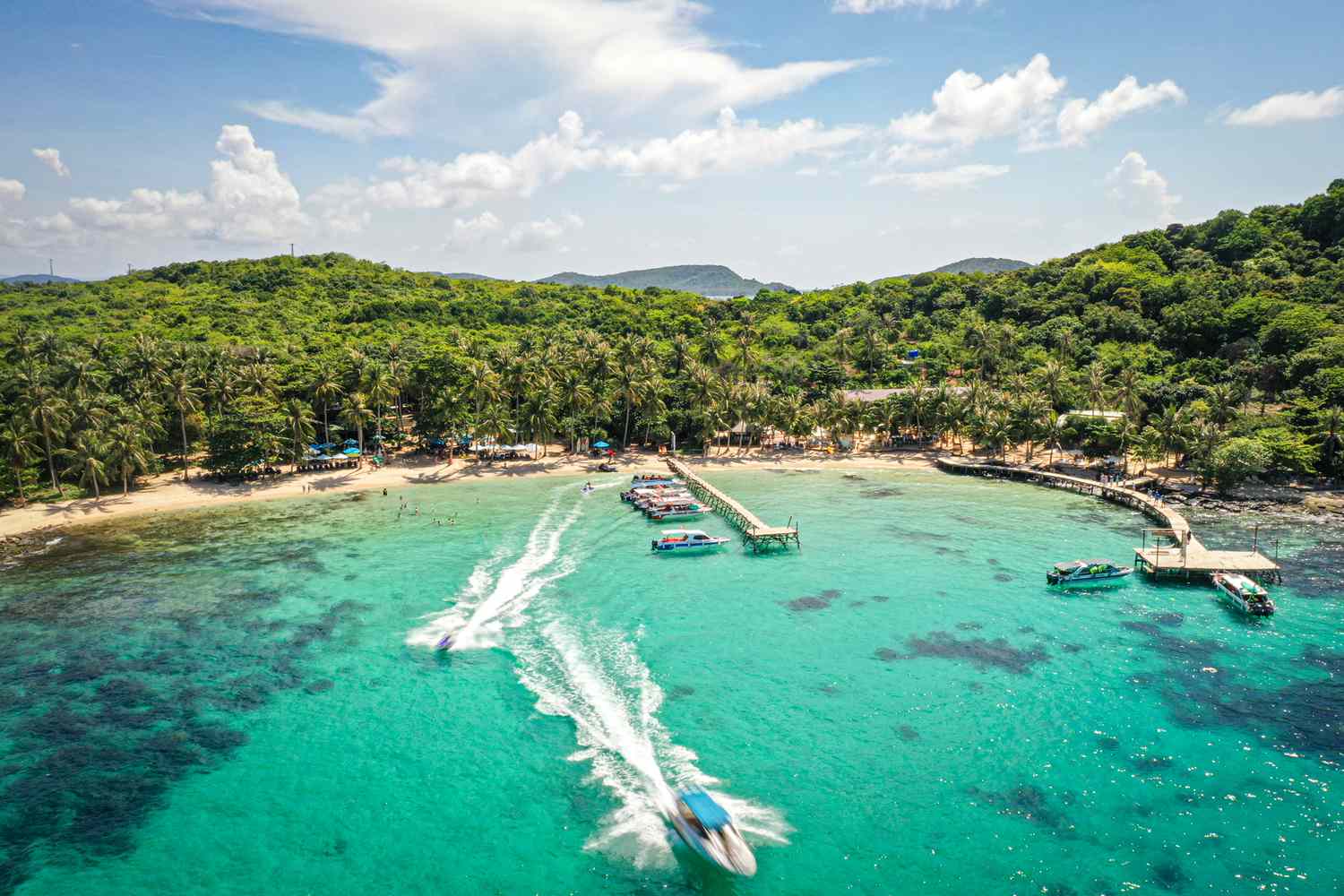
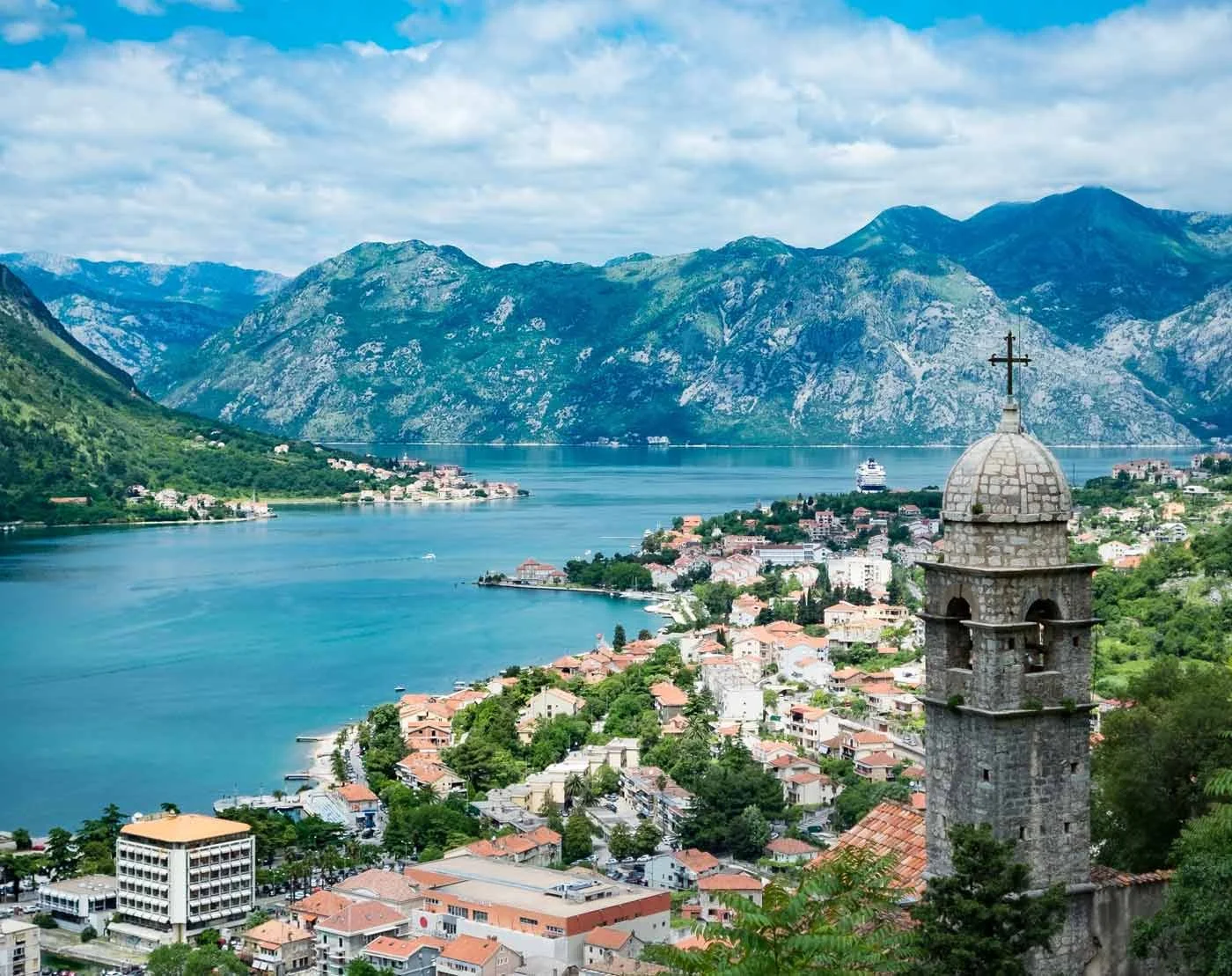

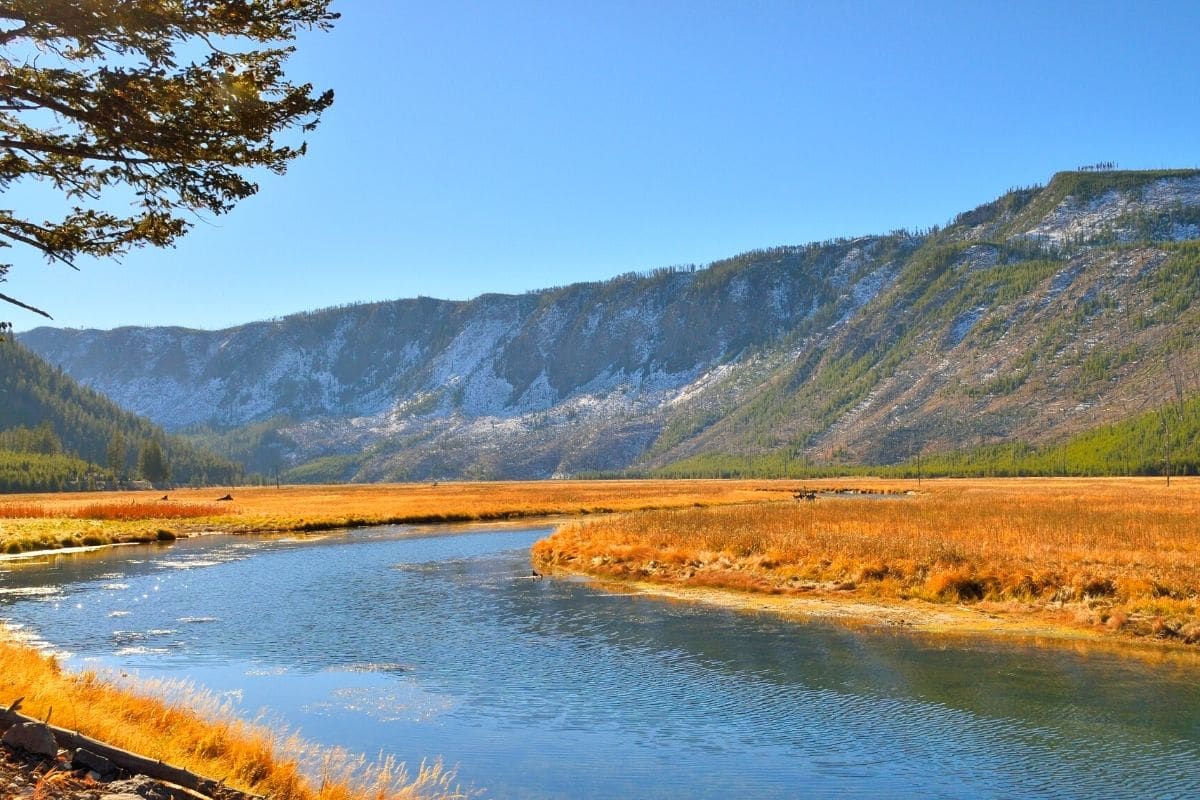

1 thought on “The Ins and Outs of Monkfish: What You Need to Know”
Pingback: All About Tripe: What It Is and How It’s Used - The Dining Destination
Comments are closed.